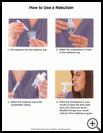
Nebulizer Home Treatment
A nebulizer is a device used with a compressed air machine that turns liquid asthma medicine into a fine mist your child can easily breathe into his lungs.
How is the home nebulizer used?
- Place the compressor on a hard surface. Make sure the filter is free of dust and dirt. If it is dirty, rinse it with water and then dry it. Plug in the compressor. Wash your hands thoroughly with soap and water before beginning a treatment.
- If the medicine is in a pre-mixed single dose vial, open the vial and put the medicine in the nebulizer medicine cup. If the medicine is not in a pre-mixed single dose vial, put the prescribed amount of medicine(s) into the nebulizer medicine cup with a dropper or syringe. If you have a question about mixing medicines, call your healthcare provider or pharmacist.
- Some asthma medicines come premixed with sterile saline. Other medicines need saline added. You can buy sterile normal saline in unit dose plastic vials. Never put a homemade saline solution into a nebulizer.
- Attach the mouthpiece or mask to the medicine cup. If a child is too young to use a mouthpiece, use a mask. Position the mask comfortably and securely on your child's face over the nose and mouth.
- Attach the tubing to the medicine cup. Turn the power on. (You should see a light mist coming from the back of the tube opposite the mouthpiece.) Place the mouthpiece in your child’s mouth or place the face mask over your child’s nose and mouth. Have your child breathe through his mouth until all the medicine is gone.
Most nebulizer cups must be held in an upright position to work well. If the mixture coats the sides and isn't being nebulized, gently tap the side of the nebulizer cup from time to time during the treatment. An average treatment takes 5 to 10 minutes. The treatment is over when all the medicine is gone, mist is no longer being generated, and the nebulizer makes a constant sputtering noise.
Some children cough up mucus after breathing treatments. Note the mucus color and thickness. Normal secretions are usually thin and white or clear. Thick, sticky mucus that is yellow or green may indicate infection. Call your healthcare provider to report a change in the color or thickness of mucus.
If your child needs more treatments than prescribed by your provider, or if the treatments do not improve symptoms, call your provider.
How and when should the nebulizer be cleaned?
If the nebulizer is not rinsed after each treatment the small holes inside the nebulizer can get clogged and will not make a mist. You do not need to rinse the clear compressor tubing.
RINSING: After each treatment take the nebulizer apart and wash the cup and mouthpiece with soap under hot, running tap water. This includes the mask or mouthpiece. Rub off any mucus stuck to equipment. Shake off the excess water.
DISINFECTING: Each day the nebulizer, mask or mouthpiece may be disinfected by using any of the following methods:
- Microwave in a special "Quick Clean" bag for 3 to 5 minutes. (Follow the instructions on the bag.)
- Place on top shelf of the dishwasher for a full cycle.
- Soak in either:
- A mixture of 1 tablespoon bleach per 1 cup water for 3 minutes OR
- 70% isopropyl alcohol for 5 minutes OR
- hydrogen peroxide for 30 minutes.
After soaking, rinse with (sterile) boiling water, then air dry.
What special instructions should be followed?
Do not increase the number of treatments within a 24-hour period without checking with your healthcare provider.
Last modified: 2011-10-28
Last reviewed: 2010-12-13

